Vol 4 No. 13 TROPIC LIGHTNING NEWS March 31, 1969
Index
Deadly Fire and Maneuver
Help Bobcats Crush 28 NVA
By SGT Jan Anderson
CU CHI
- Once again the Bobcats have shown
their proficiency for undermining Charlie's plans.
Company A, 1st Battalion (Mechanized), 5th Infantry in conjunction with
one platoon from Company A of the 2d Battalion, 14th Infantry killed 28 enemy
soldiers.
With superb co-ordination
the Bobcats worked out like a pair of kings on a full checkerboard.
Prior to setting up a night laager in the Hobo Woods, long known as an
enemy haven despite constant sweep operations, a point man of the Bobcat's
Alpha Company came under fire.
Further indication of the
enemy's presence was observed from the air where a large bunker complex had been
sighted. Two Huey Cobra gunships
were radioed in and sprayed the area with fire from rockets and miniguns.
Utilizing three platoons,
one of which was attached to Company A of the 2d Battalion, 14th Infantry, Alpha
Company commander Captain Randall L. Yeargan of San Antonio, Tex., ordered each
element to begin a cautious sweep through three separate hedgerows.
As each platoon advanced on its respective hedgerow, three individual
battles began to emerge.
The key reason for the
battle's tremendous success lay in tactics of fire and maneuver, an exercise
with which any infantry AIT graduate will feel all too familiar.
Each platoon systematically
moved into its own bunker-and-spider-hole infested hedgerow.
The third platoon, led by 1LT Paul Robinson of Otisville, Mich., was
credited with timely organization of his men and accounted for eleven enemy
dead.
Moving in the best fire and
maneuver formations, the platoon's men gave each other cover as they proceeded
to rid each bunker of its occupants.
"The only reason we were
so successful was because everyone functioned together," remarked Staff
Sergeant Roy Alexander of Peoria, III., third platoon sergeant.
According to Alexander the
biggest weapon employed against the enemy was the hand grenade.
The third platoon alone used twelve grenades to drop into individual
holes.
Other weapons also played
key roles. Specialist 4 Gerald
Murch of Glasgow, Mont., was pretty convincing with his M-60. He shot one NVA who decided to pop up at the wrong time.
Sergeant John Mondino of
Zeigler, Ill., found his M-79 grenade launcher a handy piece of hardware,
especially when he scored a direct hit on one fleeing enemy troop.
Alpha Company's first
platoon, under the leadership of 1LT Andrew C. Allred, used nearly identical
tactics to overrun its respective hedgerow.
Specialist 4 Robert Gast, of
Cincinnati, Ohio, shot one NVA who had been passed up by the lead element.
Gast's action was indicative of the teamwork employed and no doubt
saved a member of his unit from being shot in the back.
By nightfall, the ordeal had
(Continued on Back Page)
|
SAFETY IN COMBAT A SOLDIER WHO PLANS AHEAD IS A BETTER MAN THAN ONE WHO ONLY REACTS. PANIC AND UNCONTROLLED FEAR ARE FREQUENT REACTIONS OF PERSONNEL WHO ARE UNPREPARED FOR EMERGENCY COMBAT SITUATIONS. CARELESSNESS, UNNECESSARY EXPOSURE, LACK OF AGGRESSIVENESS HAS LED TO MANY INJURIES AND DEATHS. BE PREPARED AND ACCOMPLISH THE MISSION. |
Warriors
Go Underground, Find Hospital
CU
CHI -
In an airmobile assault into the Boi Loi Woods north of Cu Chi, 2d Battalion,
12th Infantry Warriors unearthed a Viet Cong hospital complex.
The 2d Brigade troops found
the first signs of the hospital only 250 yards from their helicopter landing
zone. The lead element was moving
through the heavy underbrush when the pointman spotted what appeared to be a
freshly used bunker.
First Lieutenant Tyrone J.
Staten of Gary, Ind., told his platoon to check out the area thoroughly.
Shortly thereafter the men began emerging from the tunnels and bunkers
with various forms of enemy supplies. The
security element began receiving automatic weapons fire, and the tunnel rats had
to turn their attention to the enemy himself.
The company then moved back
to the landing zone to allow artillery and air strikes to soften the enemy
positions.
Darkness delayed further
attempts to pursue the enemy until the following morning.
Two lifts returned the Warriors and Company C, 2d Battalion, 27th
Infantry to the area the next morning. The
two companies swept through the area without contact.
After the sweep the supplies were evacuated to Cu Chi.
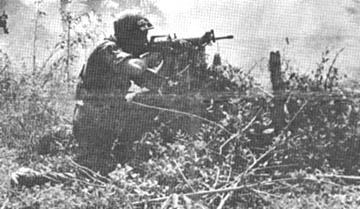 |
STEADY HOLD - Looking like a model for basic training marksmanship beginners, Private First Class Martin B. Reiss, East Meadow, Long Island, of the 4th Battalion, 9th Infantry Manchus fires into an enemy position 15 miles southwest of Tay Ninh. (PHOTO BY PFC RALPH NOVAK) |
Hawaii
Senate Resolution Cites 3 Units
CU
CHI -
The legislature of the State of Hawaii has recently recognized three Division
units in an official Senate Resolution. The
Resolution commends the men of the 1st and 2d Battalions 27th Infantry
Wolfhounds, and the 1st Battalion, 8th Artillery.
Senate Concurrent Resolution
Number 14 reads as follows:
WHEREAS,
1969 will mark the twentieth anniversary of the support of the Holy Family Home
in Osaka, Japan by the officers and men of the First and Second Battalions, 27th
Infantry and First Battalion 8th Artillery; and
WHEREAS,
the officers and men of these distinguished units are for the second time in
those twenty years engaged in combat while supporting their adopted wards, and
WHEREAS,
never in the annals of our Armed Forces has such a humanitarian project been
sustained so faithfully and for such an extended period; and
WHEREAS,
the extremely generous monthly donations by members of these units have provided
decent and happy lives for many hundreds of abandoned children and
WHEREAS,
the humanitarian actions of the members of these units personify the ideals of
brotherhood and love inherent in the word 'Aloha', now, therefore
BE
IT RESOLVED
by the Senate of the Fifth Legislature of the State of Hawaii, Regular Session
of 1969, the House of Representatives concurring, that our warmest respect and
congratulations be extended to the officers and men of the First Battalion, 27th
Infantry, the Second Battalion 27th Infantry and the First Battalion 8th
Artillery for their unparalleled demonstration of international good will and
brotherhood, and
BE
IT FURTHER RESOLVED
that certified copies of this Concurrent Resolution be forwarded to the
Commanding Officers of each of the three units through Major General E. W.
Williamson, Commanding General, 25th Infantry Division.
David C. McClung
President of the Senate
February 27, 1969
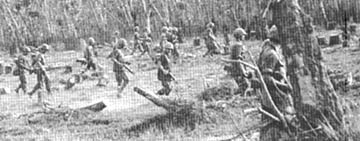 |
| DURING A SWEEP through a rubber plantation that skirts Highway 26 eight miles east of Tay Ninh City, Tomahawks of Company A, 4th Battalion (Mechanized), 23d Infantry, keep a wary eye open for signs of Charlie. (PHOTO BY SGT ROGER WELT) |
Page 2 TROPIC LIGHTNING NEWS March 31, 1969
Decorated
| BRONZE STAR MEDAL (HEROISM) | |
| LTC
William J. Cummings, HHC, 2d Bn, 14th Inf MAJ George B. Sweet, 25th MI Det CPT James F. Harvey, C Btry, 7th Bn, 11th Arty 1LT Lauren E. Johnson, 2d Bde Mobile Training Team 1LT Gary G. Martin, HHC, 1st Bn, 5th Inf 1LT James W. Conway, A Btry, 7th Bn, 11th Arty 1LT Gary W. Carlson, B Trp, 3d Sqdn, 4th Cav 1LT Michael D. Jackson, C Trp, 3d Sqdn, 4th Cav 1LT Dennis Gnas, Co D, 2d Bn, 12 Inf 1LT Andrew D. Malloy, Co B, 1st Bn, 5th Inf 1LT Jerry D. Pruitt, HHC, 2d Bn, 12th Inf 1LT John W. Slawson, Co C, 2d Bn, 27th Inf 1LT Andrew C. Allred, Co A, 1st Bn, 5th Inf 1LT Eddie G. Rigsby, Co A, 2d Bn, 14th Inf 1LT Michael D. May, Co D, 1st Bn, 27th Inf 1LT John R. Moore, A Trp, 3d Sqdn, 4th Cav 2LT Jerome P. Klar, A Trp, 3d Sqdn, 4th Cav 1SG Harvey L. Harper, Co B, 1st Bn, 5th Inf 1SG Ernest C. Randolph, Co A, 1st Bn, 27th Inf 1SG Douglas C. Raab, 25th MI Det MSG Phillip F. Dice, HHC, 1st Bn, 5th Inf PSG Robert C. Lewis, C Trp, 3d Sqdn, 4th Cav SFC Nathaniel E. Meador, Co C, 1st Bn, 27th Inf SFC Herbert D. Wright, CoC, 1st Bn, 27th Inf SSG David D. Buckner, HHC, 1st Bn, 27th Inf SSG Stephen B. Duerk, Co B, 1st Bn, 5th Inf SSG Emmanuel G. Montanez, A Trp, 3d Sqdn, 4thCav SSG Tommy Brewington, A Trp, 3d Sqdn, 4th Cav SSG Levern C. Brown, A Trp, 3d Sqdn, 4th Cav SSG Jack B. Kimberlin, B Trp, 3d Sqdn, 4thCav SSG Alejandro, Co D, 3d Bn, 22d Inf SSG William D. Shaw, Co A, 3d Bn, 22d Inf SSG Ronald D. Hughes, A Trp, 3d Sqdn, 4th Cav |
SSG
Thomas E. Kelly, Co A, 2d Bn, 12th Inf SSG Bernard R. Gdowski, Co C, 1st Bn, 5th Inf SP6 Tommy D. Bass, HHC, 1st Bn, 27th Inf SGT Billy R. Terry, Co A, 1st Bn, 27th Inf SGT La Von Freeman, Co B, 1st Bn, 5th Inf SGT Lowell E. Leopold, Co D, 2d Bn, 12th Inf SGT Cecil G. Law, Co B, 1st 27th Inf SGT William J. Haase, Co D, 2d Bn, 12th Inf SGT Roy L. Alexander, Co A, 1st Bn, 5th Inf SGT Timothy Harris, Co A, 1st Bn, 5th Inf SGT Daniel Rothstein, Co A, 2d Bn, 14th Inf SGT William A. Cargill, 25th MP Co SGT Jerry E. O'Malley, A Trp, 3d Sqdn, 4th Cav SGT Mel T. Bernard, Co F, 50th Inf SGT Gerald J. French, B Trp, 3d Sqdn, 4th Cav SGT Terry Valore, HHC, 4th Bn, 23d Inf SGT Daniel G. Updike, Co A, 4th Bn, 23d Inf SGT Glenn D. Covert, Co A, 2d Bn, 14th Inf SGT David H. Foss, Co E, 2d Bn, 12th Inf SP5 Donald E. Deck, A Trp, 3d Sqdn, 4th Cav SP5 Thomas E. Ruschkewitcz, C Trp, 3d Sqdn, 4th Cav SP4 Richard H. Losey, HHC, 1st Bn, 27th Inf SP4 Guy S. Lopez, HHC, 1st Bn, 27th Inf SP4 James A. Leonard, HHC, 1st Bn, 27th Inf SP4 Dennis A. Gilmore, Co A, 1st Bn, 27th Inf SP4 Carlton G. Harwell, Co B, 1st Bn, 5th Inf SP4 Jerome L. Bradwell, Co B, 1st Bn, 5th Inf SP4 Kenneth J. Taylor, Co D, 2d Bn, 12th Inf SP4 William C. Stuart, Co D, 2d Bn, 12th Inf SP4 Perry A. Helms, Co B, 1st Bn, 5th Inf SP4 John F. Sherwood, Co C, 1st Bn, 27th Inf SP4 Ronald A. Williams, Co D, 2d Bn, 12th Inf SP4 John C. Clancy, Co D, 2d Bn, 12th Inf |
First
Re-Enlistment Could Be 'Pot of Gold' in Your MOS
There is a 'pot of gold'
awaiting those of you who reenlist for the first time and hold one of the nearly
300 military occupational specialties designated as critical by the Army.
The pot of gold is in the
form of the Variable Reenlistment Bonus (VRB).
It can add as much as eight thousand dollars - tax free - to your regular
enlistment bonus. The VRB is only
available to men and women reenlisting for the first time.
You must also meet the following requirements:
1. You must serve at least
21 months of active service in your current enlistment before reenlisting.
2. Be in the grade of E-3 or
higher and in certain MOSs, E-4 or higher.
3. Reenlist for at least 48
additional months of service.
4. Reenlist within three
months of the expiration date of your term of service.
5. Be qualified in one of
the military occupational specialties designated as a critical skill by the
Department of the Army. These
skills are listed in AR 600-200.
If you meet all of the above
requirements, you can collect a VRB in addition to your regular reenlistment
bonus. Bonuses ranging up to
$10,000 have been paid.
The VRB critical skill areas
cover virtually all branches of the Army and all types of jobs.
Among the Critical skills are Hawk Missile Launcher repairman, field
artillery crewman, cook, carpenter, aircraft repairman, radio teletypewriter
operator, light or heavy vehicle truck driver, radio repairman, automatic data
processing repairman and data processing systems analyst.
The sum of money that first
term reenlistees receive through the VRB program can mean a lot in future years.
You can buy a car, start a stock portfolio, have enough money to get
married and raise a family, or just salt it away in the bank.
For tax purposes, the bonus paid or earned in Viet Nam is TAX FREE.
All the pertinent
information is available to you, including a U.S. Army pay rule that enables you
to figure within seconds your reenlistment bonus and VRB.
Master Sergeant Donahue, the
career counselor supervisor for the Tropic Lightning Division, has 12 full time
counselors ready to assist you.
Division reenlistment
officers are located at Dau Tieng, Tay Ninh, and three offices at Cu Chi.
Locations at Cu Chi are DIVARTY, DISCOM and the Personnel Service
Division of the division headquarters area.
If you want to call, instead
of stopping by, the telephone numbers for Dau Tieng are 148 or 240 Tay Ninh -
412 or 430, and at Cu Chi, 5234.
Tunnel
VC's Home: Be
a Home-Breaker
Over a period of almost 30
years of fighting a stronger enemy, the Viet Cong have developed extensive
underground tunnel systems. As a
result, the problem of finding and destroying his troops and supplies has become
a critical one.
TYPES OF TUNNELS
For systematic
identification and reporting, four categories have been designated by Army
Engineers. Tunnels are classified
as to size - small, medium, large, and complex.
Small tunnels are commonly
located in or near a village, and the entrances are often found in wells.
There are normally no compartments and no branch tunnels.
A variant of the small
tunnel is the ambush tunnel. As its
name implies, it is used for ambush and is usually located near a path, trail,
or road expected to be used by friendly forces.
It is generally designed to hold from three to five men and will have
only one entrance and one exit.
Medium tunnels are large
enough for a platoon or company-sized force from 30 to 50 men. They will have several entrances and exits.
Large tunnels are usually of
sufficient size to hold a battalion-sized force (150 to 300 men).
This type of tunnel may have as much as 15 meters of overburden and
contain four to five levels with large rooms connected by a network of smaller
tunnels. It is usually extensively
compartmentalized.
A tunnel complex is made up
of a series of interconnecting tunnels, rooms, and bunkers.
Tunnel complexes are constructed with several levels.
The enemy uses this type of
tunnel for almost any facility requiring a relatively large work area, including
hospitals, ordnance shops, and headquarters.
All tunnels are constructed
with sharp turns and trap doors to lessen the effects an explosion, to decrease
gas penetration, and to provide secret connections between one part and another.
They may have false branches and when vacated are normally booby trapped
and mined.
USE
OF TUNNELS
From a tunnel the enemy can
launch an attack, then disappear. They
also can provide a route for undetected passage under friendly communication
routes.
LESSONS
LEARNED
Tunnel analysis has listed
certain indicators of tunnel construction - dirt piled up under brushy
vegetation or around the base of large trees.
Here are some other tell-tale signs:
1. Soil not common to the
surrounding area or dirt found in an unusual configuration.
2. Existence of unexplained
bamboo tubes or metal pipes in the surface of the ground; these may be
ventilation tubes.
3. The enemy may withdraw to
a tunnel area after having been spotted.
4. Sniper or small arms fire
may be directed at friendly troops sweeping an area to deliberately lure them
away from a tunnel complex located on the axis along which they were originally
moving.
5. Conscription of a large
number of local people over a relatively long period of time.
TROPIC
LIGHTNING
Combat Honor Roll
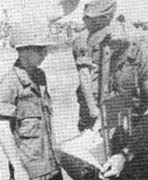 Added to this week's
Combat Honor Roll is Private First Class Lester Grigsby of A Battery, 1st
Battalion, 8th Artillery. He
distinguished himself while serving as forward observer attached to Company A,
2d Battalion, 12th Infantry.
Added to this week's
Combat Honor Roll is Private First Class Lester Grigsby of A Battery, 1st
Battalion, 8th Artillery. He
distinguished himself while serving as forward observer attached to Company A,
2d Battalion, 12th Infantry.
While established in a night
laager position, Company A came under a massive communist assault.
During the initial contact, Grigsby secured a radio and moved through the
murderous Viet Cong fire to the perimeter and began adjusting artillery fire on
the enemy.
After giving the initial
corrections to the FDC, his radio was rendered inoperable by an RPG round.
Undaunted, he exposed
himself to a holocaust of exploding projectiles as he returned to secure another
radio. After obtaining a radio, he
returned through the bullet swept area to the perimeter and effectively resumed
adjusting artillery on the hostile force.
His valorous actions
contributed immeasurably to the defeat of the hostile force. His personal bravery, aggressiveness, and devotion to duty
are in keeping with the highest traditions of the military service and reflect
great credit upon himself, his unit, the 25th Infantry Division and the United
States Army.
The TROPIC LIGHTNING NEWS is an authorized publication of the 25th Infantry Division. It is published weekly for all division units in the Republic of Vietnam by the Information Office, 25th Infantry Division, APO San Francisco 96225. Army News Features, Army Photo Features, Armed Forces Press Service and Armed Forces News Bureau material are used. Views and opinions expressed are not necessarily those of the Department of the Army. Printed in Tokyo, Japan, by Pacific Stars and Stripes.
MG Ellis W. Williamson . . . . Commanding General
MAJ John C. Fairbank . . . . . Information Officer
1LT John C. Burns . . . . . . . . Officer-in-Charge
SP4 Stephen Lochen . . . . . . Editor
SP5 Charles Withrow . . . . . . Assistant Editor
SP4 Jim Brayer . . . . . . . . . . . . Production Supervisor
Page 3 TROPIC LIGHTNING NEWS March 31, 1969
'Busiest
Airfield in South Vietnam'
Tower Treats Teeming Tay Ninh Air Traffic
TAY
NINH,
One of the busiest Army airfields in South Vietnam now has the newest, most
complete mobile control tower the Federal Aviation Administration can provide.
The new control tower is
air-conditioned, has a completely self-contained power unit and allows a 360
degree field of vision. It has a
recording system to tape all transmissions between aircraft and the tower, two
backups in the event of a systems failure, a siren and loudspeaker for alarm
purposes and a direct-reading barometric pressure altimeter.
During the troop buildup in
Tay Ninh in November, 1968, the airplane traffic more than doubled.
The inadequacies of the old tower became even more apparent.
"During November ours
became the busiest Army airfield in South Vietnam," said Major Robert C.
Scully of Adams, Mass., airfield commander.
"This is where we came
into the picture," said Captain Arthur N. Brown of Longview, Tex., serving
with Alpha Company, 588th Engineer Battalion.
"We were commissioned to erect a 54 foot tower to support the new
control room."
The Tay Ninh tower project had top priority and construction
went quickly. Cement footings were
poured and huge eight by three inch timbers were lifted into place for bracing.
A 50-foot crane did much of the heavy lifting, and when the height of the
tower passed the point where the crane could be used effectively, a complex
system of pullies designed by the 588th took over.
Without incident the timbers
were expertly raised and placed in their final positions.
Next came the construction
of several equipment shelters and a reinforced generator pad. Then after a short wait, the pre-fabricated control room
arrived from Long Binh and was lifted into place by the Army's workhorse, the
Ch47 Chinook helicopter.
The 362d Aviation Support
Detachment under the supervision of James Weaver of the Federal Aviation
Administration began to integrate the systems prepared by them for use with the
tower. Wiring was completed:
instruments were installed and tested.
Within 24 hours the tower was operational.
Air controllers in Tay Ninh
work atop one of the tallest structures in Tay Ninh base camp with a full view
of the air strip and helipads.
Twin-engined Caribous and
C-130's, and Cayuse, Cobra, and Chinook helicopters are observed and
controlled using the finest, most modern air traffic equipment.
"We are tooled up to
handle any and all problems," continued Scully.
"The crowded skies of Tay Ninh are under control."
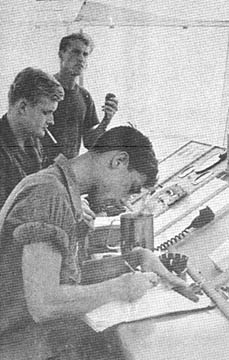 |
AT WORK - The 362d Aviation Support Detachment wasted little time in getting down to business in the new tower. Specialist 5 David J. Cranfield of San Carols, Calif., communicates with an approaching aircraft, while Specialist 5 Steven R. Wilkins of Williamson, Vt., and Specialist 4 Warren L. Finch of Croton-on-Hudson, N.Y., attend to paperwork. (PHOTO BY 1LT MACK GOODING) | |
| AN FAA mobile control tower is hoisted into place atop the 588th Engineer Battalion's structure by a Muleskinner helicopter. (PHOTO BY 1LT MACK GOODING) | 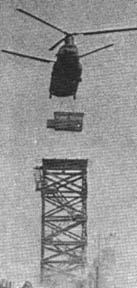 |
Regulars
Mortar VC Mortar Position
TAY
NINH
- Enemy forces launched a mortar attack on Fire Support Base Washington which
proved to be fateful for the Viet Cong.
Mortar rounds were hitting
outside the wire at Washington and were being adjusted into the center of the
base, occupied by C Company of the 3d Battalion, 22d Infantry.
Before the enemy rounds hit, the Regulars' mortar platoon was placing
suppressive fire on the enemy launching position.
Specialist 4 John Harrison
of Greensboro, N.C., was on duty in the mortar platoon's fire control center
when he spotted the flashes from the enemy tube.
"They were set up in a woodline about 1,000 meters from us," said
Harrison. "I shot an azimuth
toward the flashes and estimated the distance.
The first round was only a few meters off and the second was right on
target," continued Harrison.
A total of 283 high
explosive and illumination rounds found their objective during the action.
Three 81mm mortar tubes belonging to the Regulars were kept busy for
about three hours.
"Spooky" was flying
overhead when the attack occurred and spotted approximately 150 enemy soldiers
headed toward Washington. Along
with two helicopter gunships, "Spooky" engaged the VC and broke up their
mission.
A sweep the next morning by
the 1st Brigade troopers turned up pieces of metal which appeared to be from a
mortar tube. The enemy mortar
position was completely leveled by the suppressive fire placed on it.
|
GET READY! SET! GO! - Regulars of the 3d Battalion, 22d Infantry, prepare to charge off of a chopper as they near a landing zone close to an NVA base camp. (PHOTO BY SP4 DAVID DE MAURO)
|
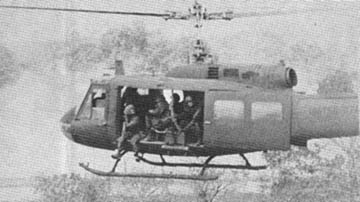 |
PSYOPS
Seeks Chieu Hois
Broadcasts Tell It Like It Is
TAY
NINH
- Every night a lone helicopter lifts off from the helipad at the 1st Brigade
base camp in Tay Ninh, carrying the 1st Brigade PSYOPS team fully armed with a
1,000 watt broadcasting system.
The team's mission: Tell
the VC and NVA forces hiding under the cover of darkness the allies' message
of peace and willingness to welcome them under the Chieu Hoi Program.
One particular night's
message had a little something extra. The
enemy troops could hear the voice of a former female comrade pleading with them
to turn themselves in.
A petite 18-year-old girl
named Hung, from the village of Ben Cau had surrendered to an ARVN ambush patrol
only two nights before. After a
quick debriefing by the ARVN forces and a full day of processing through the Tay
Ninh Chieu Hoi center, Hung was busy talking into microphones at the 1st Brigade
civic action office.
The taping session produced
a 30 minute message addressed to the members of her former VC squad.
This tape plus a leaflet bearing her message and picture were delivered
to the VC the very next night.
As a result of the special
broadcast and leaflet drop, three more members of the squad turned themselves
in, bringing their AK-47 rifles with them.
"The new Hoi Chanhs also
prepared a tape to be used on our broadcasts, and we had a leaflet printed
showing their pictures and messages," said Major Clarence M. DeYoung of San
Diego, Calif., the 1st Brigade S-5 officer.
"We hope to bring the rest of the squad shortly."
"In the past the Ben Cau
area has been somewhat of a VC-infested area, ' ' continued DeYoung.
"Lately, however, we have been making inroads due to MEDCAPS, the
security we've been providing for the villagers and now our successful PSYOPS
operations."
DeYoung noted that the
detainees are pleasantly surprised over the treatment they receive from the
ARVNs and the Chieu Hoi center and are more than willing to help persuade their
former comrades to surrender.
The 1st Brigade civic action
team is well on the way to converting VC country into a stronghold of South
Vietnamese government supporters.
Page 4 TROPIC LIGHTNING NEWS March 31, 1969
| JUST THE RIGHT SIZE - A small Vietnamese boy is just the right size to weave a basket from the inside out. Photographer SP4 R. B. Williams, caught this scene while the 2d Battalion, 27th Infantry Wolfhounds were on an operation west of Cu Chi. But life isn't all work for Vietnamese boys as the photos below show. There's time for soccer games and even some capitalistic ventures for fun and profit. | 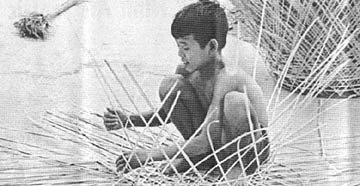 |
There
Is Time for a Little Work...
A
Little Play and a Little of Each
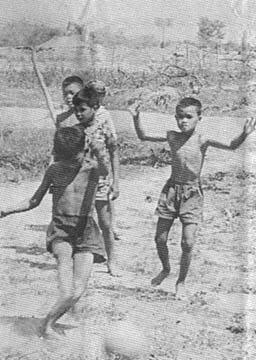 |
TIME OUT FOR SOCCER - Even outside Fire3 Support Base Mahone with its 105mm howitzers, Vietnamese youngsters find room for a game of soccer. (PHOTO BY SGT HECTOR NADEL) | |
| A COMBINATION of work and play and fun and profit is found by these small Vietnamese boatmen who offer a ferry service across a canal at a sugar mill. (PHOTO BY SP4 R.B. WILLIAMS) | 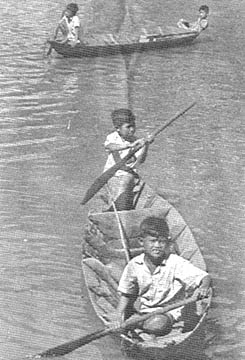 |
Page 5 TROPIC LIGHTNING NEWS March 31, 1969
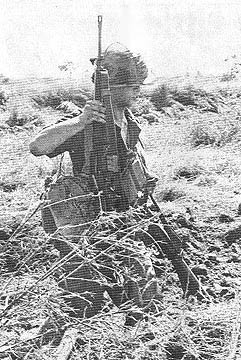 |
TEAMWORK is essential in demolitions work. As his partner readies the last charge, this demo man carries a double load to the pick up zone. | |
| TOOLS OF THE TRADE - A time fuse for a cone-shaped explosive is prepared. The charge will be placed in an enemy bunker beneath scattered bamboo. (PHOTOS BY SGT CHARLES HAUGHEY) | 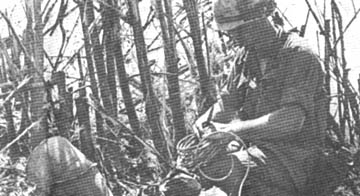 |
Moving quickly and efficiently, the demo team of the 65th Engineer Battalion destroys enemy bunkers. And Charlie's underground war is brought to the surface.
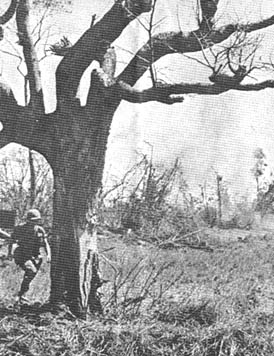 |
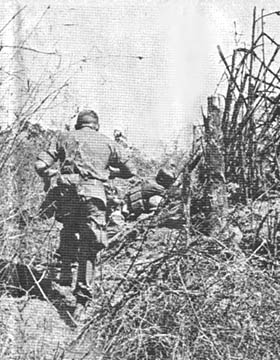 |
|
| A DEMOLITION TEAM member hustles to put distance between himself and the last explosion as an earlier charge explodes right on schedule. | WITH A FUSE behind him already burning, a demo man races past his working comrade to begin setting the next charge. The leap-frog method was necessary to destroy an enemy bunker complex quickly before his company was to leave on an eagle flight. |
Page 6 TROPIC LIGHTNING NEWS March 31, 1969
Floppy,
a Homing Pigeon Dog Jumps Eagle, Makes It Back
TAY
NINH
- Rin Tin Tin, Lassie and Yukon King have nothing on Floppy, the all purpose
point dog-mascot-homing pigeon of the 4th Battalion, 9th
Infantry Manchu's Charlie Company.
However dubious his pedigree
might be, Floppy has established his value and loyalty to the Manchus, most
recently by finding his way back to their Fire Support Base Sedgwick across
seven miles of Vietnamese countryside after missing the return eagle flight of
an airmobile operation.
Charlie Company had left
early in the morning for the operation, and by noon had reached its pickup zone,
recalled Private First Class Norman L. Russell, Indian Rocks Beach, Fla.
"When the second wave was
set to go, Floppy jumped in the chopper with our CO (Captain Ramon T. Pulliam,
Chattanooga, Tenn.), where he usually stays," Russell said.
"But just as we were taking off, Floppy jumped out, and we thought
we'd lost him. Everybody was
feeling pretty bad about it, too."
Around 11 p.m., however,
Floppy came prancing jauntily into the Charlie Company command bunker, having
made his own way over seven miles, crossed the 100-yard-wide Cam Vo Dong River,
and infiltrated the maze of barbed wire that surrounds Sedgwick, which used to
be Patrol Base Mole City.
The Manchus welcomed the
unscathed Floppy back with a couple of cans Of C-rations, and their relief at
having him return wasn't just sentiment, according to Private First Class
Michael W. Tanner, 610 N. Ridgeway Lane, La Habra, Calif., Pulliam's
radio-telephone operator.
"Floppy always stays right
up with our point man, and he can smell the Viet Cong long before they can
ambush us," Tanner said. "He
hasn't failed us yet and even when we were hit here at Sedgwick, he was
restless and barking all night."
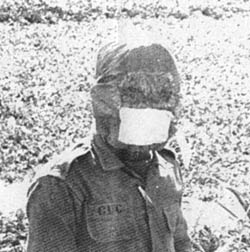 |
A SOUTH VIETNAMESE RF-PF SOLDIER models a VC gas mask found in a cache southeast of Fire Support Base Reed. The allied soldier was on a sweep with 2d Brigade troops from D Company, 2d Battalion, 27th Infantry. (PHOTO BY SP4 KARL KARLGAARD) |
Lightning
Strikes Twice For Sergeant First Class
DAU
TIENG
- Most people maintain that lightning never strikes twice, but for Sergeant
First Class Robert S. Spears of Mount Holly, N.J., it has—once in Germany and
now in Vietnam.
Spears' first encounter
with lightning occurred in 1944. He
was a young sergeant, just finishing desert training at Camp Clipper, Calif.,
and on his way to England with the 578th Field Artillery Battalion.
After several months of
training, the 578th landed on Normandy Beach after D-Day.
When the call came for volunteers to fill infantry units before the
Battle of the Bulge, he volunteered.
ZAP!
He was assigned to the 78th Lightning division.
After Fierce fighting with
the 78th in Belgium, Remagen and the Ruhr Valley, where he received the Bronze
Star with V, Spears returned to the states and was discharged in 1945.
One year later he returned
to the Army as a military policeman, and spent most of the next five years
serving with units of the 82nd Airborne Division, where he earned the
Master Parachutist Badge.
After a brief stint in
Europe, Spears was assigned as a prisoner of war escort guard in Korea in 1953.
Following several more tours
in Europe, lightning struck him the second time.
He was assigned to the "Tropic Lightning" division where he serves
with the 3d Brigade. He serves as
administration supervisor in the adjutant section of brigade headquarters at Dau
Tieng.
APO
Mission - Lift Morale
DAU
TIENG
- Load 16 tons and what do you get?
Just about two weeks' work
for the postal clerks at Army Post Office 96268 in Dau Tieng, that's what.
The busy mail clerks at the 3rd Brigade APO handle nearly a ton of mail
every day - and better yet, that ton of letters and packages is distributed to
the troops "ASAP."
Staff Sergeant Jimmy Arnold
of Odessa, Texas, and his six-man section pride themselves in the speed with
which they deliver much-wanted letters to the men of the 3rd Brigade.
Transportation of mail from Tan Son Nhut and Cu Chi to Dau Tieng isn't
as frequent as they would like it to be, but Arnold and his boys do their best
to see that once the mail arrives it is distributed in no time flat.
In addition to its routine
postal functions, the APO provides financial services for men of the 3d Brigade,
and, as if this weren't enough, it handles personal baggage for medical
evacuees.
Besides handling incoming
mail, the clerks ship out about 500 pounds daily.
During Christmas season, of course, this figure is almost tripled.
Arnold recalled last
Christmas' daily average of 5,000 pounds.
A back-breaking 10,000 passed through APO portals one day during that
season.
Surely men like Arnold and
his postal specialists should be counted among the ranks of the proverbial
'unsung heroes' of war.
Lucky
Medic Listed QIA
TAY
NINH
- While on an air-mobile operation six miles north of Tay Ninh City, Specialist
4 Greg Hara of San Jose, Calif., almost became the first American soldier to be
quilled in action.
Hara came across a runaway
porcupine who was fleeing the troop movement.
"I didn't know what hit me," said Hara.
"I was walking along a jungle trail with the rest of the group when he
came running out of the brush and hit my left ankle. At first he was stunned, but then he got up and ran off."
Hara is a medic with Charlie
Company, 3d Battalion, 22d Infantry.
Page 7 TROPIC LIGHTNING NEWS March 31, 1969
 |
| ON LINE - Tropic Lightning soldiers from the Fighting Aces of the 2d battalion, 34th Armor, mount up for a mission. |
Dreadnaughts'
AO: Saigon
to the DMZ
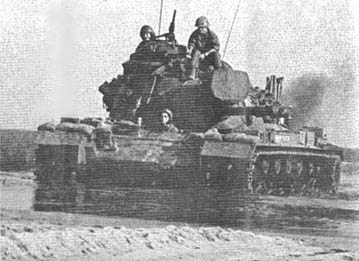 CU
CHI -
The 2d Battalion, 34th Armor, commanded by Lieutenant Colonel Duane Teaque of
Terre Haute, Ind., has one of the most widespread areas of operation of any unit
in the 25th Infantry Division.
CU
CHI -
The 2d Battalion, 34th Armor, commanded by Lieutenant Colonel Duane Teaque of
Terre Haute, Ind., has one of the most widespread areas of operation of any unit
in the 25th Infantry Division.
Alpha, Delta, and
Headquarters companies of the 34th work primarily in the Tropic Lightning
division area. They provide mobile
striking power for 2d Brigade infantrymen.
Cu Chi is the base of
logistical operations for the Battalion. Delta
Company provides the support specialties for maintaining an armor battalion in
the field.
Bravo Company of the 34th
Armor supports operations of the 1st Infantry Division near Lai Khe, while
Charlie Company operates out of camps Evans and Eagle north of Hue.
Company C, nicknamed
Fighting Aces by General William Westmoreland, is under the operational control
of the 101st Airborne Division (Airmobile), in the northern I Corps area.
The Dreadnaught armor works
closely with the 3d Squadron, 4th Cavalry, in combined armor operations. A
recent mission became a textbook example of the value of armor in Vietnam.
Charlie Company of the 34th
Armor was conducting a combined operation with airborne infantrymen and South
Vietnamese Popular Forces in the Dong Hoa area.
The combined operation drove to the planned line of departure with the
infantry mounted on tanks. Then
while a 15 minute barrage of artillery prepared the forward area, the
infantrymen dismounted and fanned out between the 12 tanks on line.
As the last artillery round whistled overhead, the task force moved out.
While they swept the area the Dreadnaught armor provided reconnaissance
by fire in areas of suspected enemy concentration.
Suddenly an observation
helicopter received fire from five locations.
Dropping white smoke, the chopper pulled back behind the tanks.
Canister, high explosive (HE), 7.62mm and .30 caliber rounds pounded the
enemy positions.
Smoke, blasts and tracers
pointed deadly fingers at the enemy. Soon
there was no more enemy fire.
MAKING
WAVES
- (Above, right) Displacing 52 tons of water, a
Dreadnought tank "swims" through a stream near Hue, where the armormen are
under the operational control of the 101st Airborne.
|
Story and Photos by SP5 Doug Elliott |
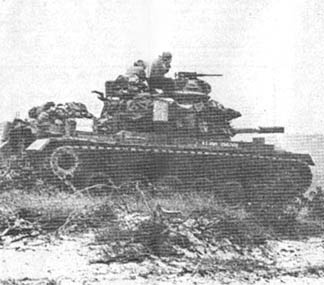 |
DOWN RANGE - A high explosive round screams off toward a suspected VC sniper position from a Fighting Aces tank. |
| COMBAT ASSAULT - With the combined elements of the 101st Airborne and South Vietnamese Popular Forces 2d Battalion, 34th Armor, troopers sweep across the sands in northern South Vietnam near Long Hoa. | 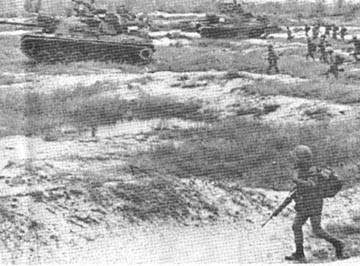 |
Page 8 TROPIC LIGHTNING NEWS March 31, 1969
Staunch
UpTight Artillerymen Save HQ From Enemy Siege
DAU
TIENG
- "Up Tight" artillerymen of the 2d Battalion, 77th Artillery, fought as
infantrymen to save their headquarters and fire direction center from being
overrun.
During a massive North
Vietnamese Army attack on Dau Tieng base camp of the 3d Brigade in which 73
enemy were killed, the Up Tight Battalion headquarters was threatened.
Specialist 4 Phillip Fadley
of Anderson, Ind., was the first to spot a group of NVA sappers who had
penetrated the perimeter. The enemy
troops were inside the Battalion motor pool placing satchel charges.
The enemy force was apparently maneuvering for position from which to
attack the fire direction center, which is in a large underground bunker.
Fadley alerted a group of
cannoneers including Major Robert Moose of Russellville, Ark., Up Tight
executive officer. Moose led a patrol of artillerymen in defeating the enemy
attack.
Moose, Fadley, Sergeant Roy
Lischinsky of Tillson, N.Y., and Private First Class Charles Bailey of
Barberton, Ohio, opened fire on a group of NVA in the motor pool, hitting two
and pinning down the remainder.
As they kept the enemy glued
to the ground, Specialist 4 Merlin Beedy of Garden City, Ka., crept forward from
his position atop the fire direction center to a small trench alongside the
motor pool. From there he threw
hand grenades at a suspected enemy position.
A sweep of the motor pool
the following morning turned up six enemy bodies in the motor pool.
As dawn broke, Specialist 4
Stephen V. Ladouceur of (14111 Sorrento Abe.) Detroit, Mich. spotted an enemy
sniper in a tree across the airstrip. Ladouceur,
who is a driver for the Up Tight battalion commander, Lieutenant Colonel Vernon
Lewis of Marshall, Tex., leveled his M-16 rifle and brought the sniper down.
Commenting on the men's
fighting efforts, Moose said "my artillerymen did an outstanding job of
rooting out the enemy. They
displayed great courage and coolness under fire.
They fought in the best tradition of our battalion."
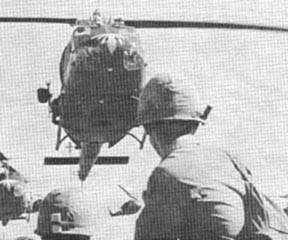 |
FAST AND PRECISE—Hornet slicks of the 116th Assault Helicopter Company drop in to extract 2d Brigade soldiers from he 2d Battalion, 12th Infantry, after a sweep north of Cu Chi. (PHOTO BY SGT. CHARLES HAUGHEY) |
The
VTR Unsticks the Stuck
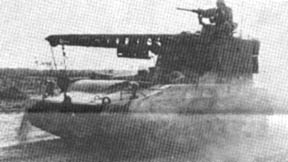 TAY
NINH
- An emergency call flashed over the radio. An
armored personnel carrier from 4th Battalion (Mechanized), 23d Infantry was
stuck in the mud off Highway 26, eight miles east of Tay Ninh City, it was
imperative that the APC be pulled out immediately.
TAY
NINH
- An emergency call flashed over the radio. An
armored personnel carrier from 4th Battalion (Mechanized), 23d Infantry was
stuck in the mud off Highway 26, eight miles east of Tay Ninh City, it was
imperative that the APC be pulled out immediately.
The distress call was
quickly relayed to the Battalion's support platoon, and without delay the
Tomahawk support element went into action.
A VTR (vehicle track
recovery) and its three-man crew raced to the scene.
"We were ready to move out
seconds after the call for help came in," said Specialist 4 Carol Sigmon of
Vale, N.C. "Within minutes we had
pulled the APC out of the mud and back onto firmer ground."
This was a typical mission
for the men of the Tomahawk support platoon.
They remain on-call 24 hours a day to answer any emergency that might
arise.
The VTR, better known as the
"track retriever," is a machine of many talents, ranging from towing armored
personnel carriers to lifting barbed wire out of five ton trucks. The
versatility of the VTR has exceeded all expectations in Vietnam.
"Working the Tomahawk
support unit has been a very interesting experience," said Specialist 4 Robert
R. Mason of Box 85, Hardesty, Okla. "Though
the hours are long, it's very satisfying to know that what you are doing is
appreciated."
(Above,
right) A
VTR,
commonly called 'track retriever' from the 4th Battalion (Mechanized), 23d
Infantry rumbles down Highway 26 on its way to help a disabled Tomahawk armored
personnel carrier. The track
retriever has proved its worth again and again, from towing large vehicles to
lifting barbed wire from five ton trucks. (PHOTO
BY SP4 ROGER WELT)
Regulars
Take Tip, Find Readied Rockets
TAY
NINH
- While on a reconnaissance mission four and one-half miles north-east of Tay
Ninh City, Bravo Company, 3d Battalion, 22d Infantry uncovered three 107mm
rockets ready for firing.
The rockets were found in a
well only one mile north of Fire Support Base Buell.
The Regulars were tipped off about the location of the rockets by a
Vietnamese boy who was tending cows in the field. The boy was rewarded for his help under the Voluntary
Information Program which pays piasters to civilians when they lead allied
troops to enemy supplies.
"The Vietnamese boy was
very happy and proud of what he had done," said Bravo Company commander First
Lieutenant Hugh E. Stephans of Charleston, S.C. "He approached one of our Vietnamese scouts, Vo Van Dang,
and told him in Vietnamese about the whereabouts of the rockets. My
interpreter, Staff Sergeant Tran Hau Tinh, informed me what was happening, and
after we pulled the rockets out of the well I gladly rewarded the boy."
The Regulars' S-5 Master
Sergeant Paul Gargis of Lima, Ohio, commented on the program.
"The Voluntary Information
Program offers a great deal of incentive to youngsters, especially," said
Gargis. "Once they have found out
that they will be rewarded for their finds, they will hunt far and wide for
weapons. Their help means a great
deal, since it aids us in capturing the enemy's weapons before he can use them
against us.
Bobcats...
(Continued From Page 1)
lasted
three hours. Illumination flares
gave the Bobcat Company enough extra light to thoroughly rid the area of enemy
soldiers. The next morning the
company again swept the area of the previous day's contact.
The NVA unit paid a high
price for its initial sniper fire. Twenty-eight
enemy lost their lives to the mechanized units, and blood trails were found
leading away from the area.
Of the trophies taken,
probably the most impressive was a .30 caliber machinegun mounted on wheels.
Other weapons captured
included 14 AK-47 assault rifles, 1 60mm mortar tube complete, 40 CHICOM
grenades, 40 rounds of butterfly bombs, 7.82mm mortar rounds, 2 RPG-2 launchers,
3 RPG-7 launchers, 20 RPG-2 rounds, 5 RPG-7 rounds and numerous documents.
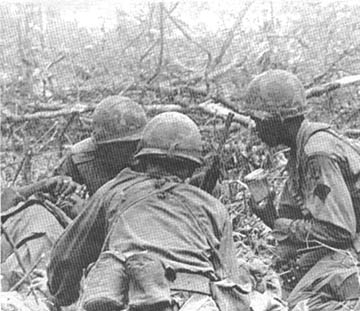 |
| ADMINISTERING PLASMA to wounded member of his unit during recent action is medical aidman Specialist 4 Rondual E. Tice of St Petersburg, Fla., assigned to the 2d battalion, 12th Infantry. During the battle, elements of the 2d Brigade killed 170 members of an estimated NVA Battalion near Trang Bang. (PHOTO BY MAJ JOHN FAIRBANK) |
Thanks to
Mack D. Gooding, 15th PID, 1st Bde., for sharing this issue,
Kirk Ramsey, 2nd Bn., 14th Inf. for creating this page.
This page last modified 8-12-2004
©2004 25th Infantry Division Association. All rights reserved.